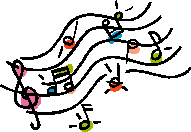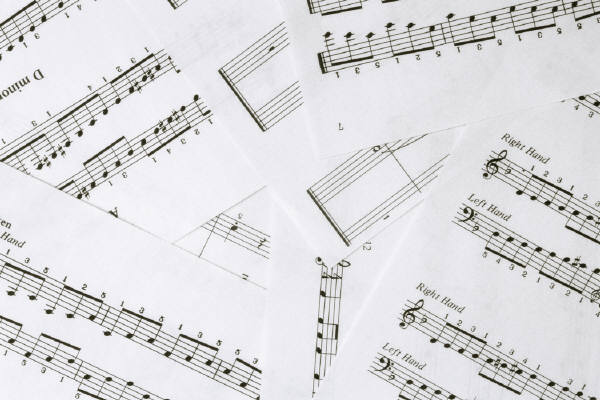Wednesday, August 27, 2008
What is "sonata form"?
Sonata form is a very rigid method of musical composition; it can refer to either an entire piece of music or the first movement of a symphony. Though sonata form is an integral part of a symphony, sonata form as an entire piece of music tends to be a bit more complicated as more attention and time is given to each individual part within the intricate composition.
Sonata form is generally divided into five parts: introduction, exposition, development, recapitulation and coda. The introduction within sonata form is generally the shortest part of the piece, at times omitted completely if it isn't completely necessary. A sonata form introduction is often dynamic-building, a slower part that increases with weight as it moves forward, pushing the song toward the exposition -- the most important part.
The sonata form exposition is the meat of the song, the area in which the major thematic subjects are introduced. The exposition itself is divded into a series of subject groups. The first subject group in sonata form introduces a theme, followed by a brief transition used to switch keys. The second subject group brings altered melodies into the sonata form in a different key than the first group; it is primarily used to change the piece's mood. It is followed by the sonata form codetta, which revisits various themes within the exposition and signals the end of the part.
Sonata form development is exactly that: development of the subject found in the exposition. In order to make the sonata form development work effectively, however, the subjects have to be very altered, sometimes introducing one or two elements completely new to the song. It is followed by the sonata form recapitulation, which revisits the exposition. It is divided into the same groupings as the original exposition with the parts unchanged -- except for the transitional key change, which is usually abandoned.
The final part of the sonata form is the coda, a part that essentially repeats the end of the song. The sonata form coda can, of course, be altered, but it is rarely so altered as to become unrecognizable.
Tuesday, August 26, 2008
What in the world is "polytonality"?
Polytonality is the act of using more than two keys (or tonalities) at the same time, in the same piece of music. Bitonality, though often considered to be a part of polytonality, is the act of using only two keys at the same time. Both of these techniques create tension and ambiguity. A fully harmonized polytonality will sometimes add a sense of discomfort (though it doesn't necessarily have to). In fact, a polytonal song often ends with the dominant key in order to keep the song from feeling restless or unresolved.
Polytonality rose to popularity in early 20th century classical music. Though it had been used before in pieces such as Beethoven's Eroica Symphony, it wasn't until the early 20th century that composers began to really explore its possibilities. In some ways, polytonality hit its stride with Arnold Schoenberg, even though he didn't directly experiment with the form. After years of composing and pushing tonality to its limits, he decided to abandon the concept altogether. This created a concept called atonality. At the same time, Igor Stravinsky (who was also frustrated with the constraints of tonality) began experimenting with polytonality as a way to break through the tonal walls. These two concepts, polytonality and atonality, eventually unofficially banded together to form a musical movement based on the era's increasing irritation with strict musical rules. This movement brought polytonality to the fore and led many musicians to experiment with the idea.
The most well-known examples of polytonality are found in Stravinsky's ballet Petroushka (which is actually bitonality) and his piece The Rite of Spring. And while Stravinsky eventually went on to experiment with serialism, many other 20th century composers took his cue and used polytonality in their pieces. Charles Ives, for example, was one of the first to use fully harmonized bitonality in classical music; Darius Milhaud also used it frequently. Other notable composers involved with polytonality include Gustav Mahler and Phillip Glass.
Monday, August 25, 2008
What is a "musical canon"?
__A musical canon is a piece of music that showcases one melody adapted to various forms, each form shadowing the other. Perhaps the most well-known musical canon is "Pachabel's Canon." It's an amazing example of how the form works; one melody is changed slightly over the song's duration and the variations shadow each other at set points. But the melody in a musical canon doesn't necessarily have to change. Consider the "Row, Row, Row Your Boat"-type round; the melody in this musical canon stays exactly the same, letting the shadowing take center stage.
The musical canon comes in numerous shapes and sizes, but the most familiar (and frequently used) types are the inverse musical canon, the contrapuntal canon and the backwards canon. The inverse musical canon is precisely what the name denotes: a musical canon in which one or more melodies are inverted. Note, however, that this doesn't mean the melody itself is played backwards; the inverse musical canon inverts only intervals -- where the lead melody moves a third up, for example, the following melody moves a third down.
The contrapuntal musical canon is like "Pachabel's Canon"; the melodies are all slightly different but work well together and shadow each other in the same places. The shadowing is the most important thing in the contrapuntal musical canon, as how the melodies link together will ultimately determine their ability to complement each other.
The backwards musical canon is exactly what the inverse musical canon is not; it's a musical canon in which the following melody is played backwards from the lead melody. It's almost like reversing a tape loop; the intervals stay exactly the same, as do the notes, but they're played in the reverse direction from the lead melody in the musical canon.
Friday, August 22, 2008
What is "syncopation"?
Syncopation is a rhythmic technique achieved by placing the stress, or accent, on a normally unstressed beat. Rhythm functions on a series of stressed and unstressed beats that drive the underlying meter. The time signature dictates which beats are to be stressed; for example, typical 4/4 time stresses the first and third beats, while 3/4 stresses only the first. Syncopation would place the stress on a beat other than those mentioned; in 4/4, syncopation might put the stress on the second and fourth beat, for example. Anytime an accent is played on a beat other than that traditionally stressed (regardless of instrument, though drums in pop music usually dictate this), it's syncopation.
Syncopation isn't only found on the straight unstressed beats of a song, however. Often, syncopation will be achieved by placing the stress on the upbeat. Tap your foot in 4/4 time; the point at which your foot is in between taps is the upbeat. This type of syncopation is a half-step off from any defined straight beat and can be used to create energy within a song. Traditional polka and modern ska (a reggae-infused style of rock music) often employ upbeat syncopation within songs; in fact, upbeat syncopation has become the main defining characteristic of modern ska music.
Playing or singing a note just before or after the beat also constitutes syncopation, though this is a trickier sort. Because there's no defined beat on which the syncopation can fall, it takes great care on the musician's part to avoid making this sound like an accident. This type of syncopation requires a natural sense of rubato for the piece in question and can add miles of space to the song's character if used correctly. Rhythm & blues and soul music often use this sort of syncopation, and it has spread to be included in the rhythmic lyrics of many hip-hop songs.
Thursday, August 21, 2008
What is a "serenade"?
A serenade is a piece of music intended to honor a specific person. Though there exists a variety of different types of serenade, the most modern and common notion of the serenade (or the concept of serenading someone) is based on the earliest of all its forms. It's simpler than the majority of serenade styles; just a piece of music played for someone in their presence. During the Medieval era, this performance was usually done underneath the intended's window, which is where the modern pop-culture reference comes from. This type of serenade is all over television and movies; heart-struck men camp out with a guitar underneath their beloved's window, waiting to play the song they so desperately toiled over. And in some cases this serenade notion has taken an extremely modern twist; in the movie "Say Anything," John Cusack's character serenades his loved one by playing a Peter Gabriel song on a large, hi-tech (at least for the time) boom-box. The rules of serenade tradition might be gone, but the general idea is still there.
But aside from that commonly referenced style, the serenade is also a sort of music in its own right. This type of serenade, popularized by Italian and Austrian composers, is a multi-movement piece of music intended for a symphony orchestra. It's less rigid than many symphonic compositions of the time, reflecting a light playfulness very indicative of love and happiness. And also unlike the symphony, this type of serenade is solely dependent on sounds and the mood created by those sounds as opposed to subject exposition and recapitulation. This type of serenade is found most frequently within the Romantic and Classical eras of composition, though it's carried over (and evolved) to modern classical compositions in the form.
_____________________________
Wednesday, August 20, 2008
What Are "Time Signatures"?
Time signatures are the area of western musical notation that give specifics about time and how it will function within the song. The importance of these two numbers is apparent by their placement alone; time signatures are literally the second thing a musician sees, after the clef. One glance at the time signatures and the musician is able to put the entire song into context; not only do time signatures denote rhythm, they can also tell quite a bit about style and genre.
Time signatures consist of two numbers placed vertically on the staff. They appear right after the key signature (if there is one) or the clef (if there isn't). Each number says something different about the piece of music: the top note indicates how many beats are in one measure of music, the bottom indicates which type of note makes a beat (or "gets the beat," in musician-speak). For example, times signatures of 4/4 tell a musician that there are four beats per measure of music and that the quarter note is one beat.
But time signatures aren't always so easy. The above explanation only applies to one type of time signatures, simple time signatures. 4/4 is the most common of the simple time signatures, but 3/4 and 2/4 are used frequently, as well. The other type of time signatures, compound time signatures, tends to be a bit more complicated. Compound time signatures are recognizable by a top number of six or higher that is always divisible by three, like 6/8. To figure out how many beats exist per measure, the top number is divided by three; so in 6/8 time signatures, the top number wouldn't say that there are six beats per measure, but rather two. Likewise, the note type is found by multiplying the bottom number's note value by three; an eighth note doesn't get the beat in 6/8 times signatures, but the dotted quarter note does (a quick note: the note value in compound time signatures will always be dotted). 6/8 and 12/8 are two of the most common compound time signatures, used heavily in waltzes and blues, respectively.
But even compound time signatures don't cover the broad spectrum of rhythms that time signatures have to offer. No, there are still times that a rhythm is so odd, so seemingly offbeat, that the time signatures must be similarly irregular. And that's how we get to irregular time signatures, time signatures that can be categorized into simple or compound, but because of their rare usage and strange rhythm aren't really categorized as such -- like 5/8 or 10/4. Time signatures like these are found pretty frequently in innovative rock and pop groups. The most famous examples of irregular times signatures are found all over Pink Floyd's "Dark Side of the Moon," but bands like Rush and Genesis (early Genesis, before Phil Collins stepped away from the drums) have also used them to marvelous effect.
Monday, August 18, 2008
What is a "polka"?
The polka is a Czech genre of folk dance and music started in Bohemia in the 1830s. It's quick and lively; polka music is always played in 2/4 with four verses and as many repeated choruses (though sometimes the chorus is repeated after every other verse). Unlike many dance-music genres, polka is lyrically solid -- and incredibly diverse. Polka originated in the peasant culture, so the lyrics often reflect that life; and though polka lyrics can really be about almost anything, love and the loss of love seem to be the most common themes.
The polka is distinguishable by a few familiar characteristics. The music itself is very recognizable, some forms creating the oom-pah sound that many identify with only polka. It's always played with a bass, piano and horn section (usually including a tuba), but the most identifiable instrument in polka is the accordion. An image of a man playing an accordion in traditional Czech folk clothing is one that comes to mind for many people when polka is mentioned. The dance, too, is very distinguishable, if only for its vivacious energy. The polka dance is based on a half-step hop taken before the actual step. This hop almost serves a primer for the rest of the dance, and it's what makes the polka dance seem so incredibly bouncy and energetic. The informality of the dance also contributes to its carefree connotation. A typical polka dance will have no strict formation on the dance floor; dancers are free to move around the floor in whatever way feels most comfortable to them and the other dancers.
Though it's often associated with a nerdy, boring lifestyle (parents through the eyes of teenagers are always listening to polka), polka is still wildly popular within the United States. Throughout the years, however, it's morphed into a variety of forms, many of which are extremely regional. The Polish polka is found mostly in Chicago and encapsulates a number of styles. Slovenian polka, which is faster than traditional polkas, is often danced in Cleveland, and Dutch polka (the most familiar and popularized type) is the province of the Midwest.
Sunday, August 17, 2008
Fake piano in opening ceremonies at Olympics?
Fake piano?
Is it possible that a plastic or cardboard piano was used as a prop in the opening ceremonies at the Beijing Olympics? The piano seemed to bounce around as it was played more than a normal grand piano would. And there seemed to be something unnatural about the way the sustain pedal was used.
If so, why would they do that? There doesn't seem to be any point to it. Take a look at it for yourself and see what you think. Go to: http://en.epochtimes.com/n2/china/lang-lang-fake-olympics-2829.html
Saturday, August 16, 2008
What does "modulation" mean in music?
Modulation
Modulation is a fancy word for key change -- switching from one key to another in a single piece of music. It is a common practice in composition (both classical and rock or pop) and can be used to a variety of effects. Modulation can be subtle and smooth or abrupt and startling. It can cast an eerie glow on a piece of music or completely change the mood and direction. The effect achieved, however subtle or abrupt, is largely dependent on the type of modulation used.
The most common type of modulation is called pivot chord modulation. In this type of modulation, the key changes based on a chord shared by both keys; the destination chord often has the same root note or quality as the original chord. This allows for a smooth, almost foreshadowed modulation. A good example of this is found in the last chorus of rock songs; this type of modulation is used there to an almost triumphant effect.
Another common type of modulation is pivot tone modulation. Similar to pivot chord, pivot tone modulation uses a common pitch to move from key to key. This type of modulation is also subtle, depending on the piece of music in which it is used. It can, however, be used to a startling effect if the two keys have few notes in common. In songs using pivot tone modulation, the common pitch is often sustained or repeated and used a bridge between the two keys.
The most abrupt kind of modulation is direct modulation. The name is exactly what is says it is: a direct modulation using no common note or chord to bridge the two keys. When used correctly, direct modulation is shocking and can easily change the song's mood. This type of modulation switches keys either at a phrase's end (phrase modulation) or at a point in the middle of the song (static modulation).
____________________________
Friday, August 15, 2008
What is "Harmony"?
Harmony is a series of notes in combination, played simultaneously or at least tangent. Listen to your favorite songs, and pay close attention to the back-up vocals when they're being sung along with the lead. Can you hear how the two vocal melodies differ in pitch? That's harmony, and it's highly possible that those back-up vocalists were chosen because of their strong ability to harmonize. Singing a harmony, or rather picking one out on your own without written sheet music, is an almost inherent musical skill that many singers would die to possess. But harmony isn't just the province of singers; it's found in every single area of music. Any time a sound is layered on top of another sound and those sounds match each other in rhythm and melody (but not pitch), a harmony is created.
Harmony is made of intervals, and as such, it can be considered dissonant (scratchy, uncomfortable, like playing an E and an F at the same time) or consonant (pleasing or smooth). What makes a harmony pleasing or unpleasing, however, is extremely relative. In medieval times, only octaves and perfect fifths were considered harmonious, and any harmony that deviated from that was generally frowned upon. In modern western music, though, nearly everything is considered to be harmonious by someone. Fifths are still very popular in modern harmony but are now used in the most unlikely of places; heavy metal music, for example, frequently uses perfect fifths in the vocal harmony to create an eerie effect when layered on top of the more dissonant instrumentation.
In addition to being consonant or dissonant, can also be subordinate or coordinate. Subordinate harmony, the tonal harmony used most frequently today, is a series of harmonies that are based on each other. The harmony moves in such a way that a resolution is somewhat predictable; you can hear this type of harmony in modern pop music, musical parts that flow very easily into each other and don't leave the listener baffled as to the turn the song has taken. On the other hand, coordinate harmony is a series of harmonies that operate independently of each other. They do have some common relation, of course, but don't typically move toward a goal, or predictable resolution. Renaissance musicians often used this type of harmony, and it's capable of producing rich and moving textures within a piece of music.
__________________________
Subscribe to:
Posts (Atom)











